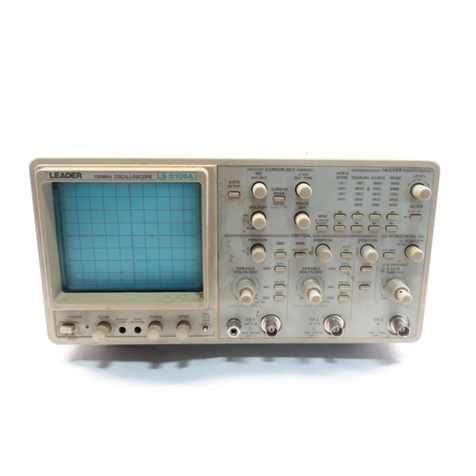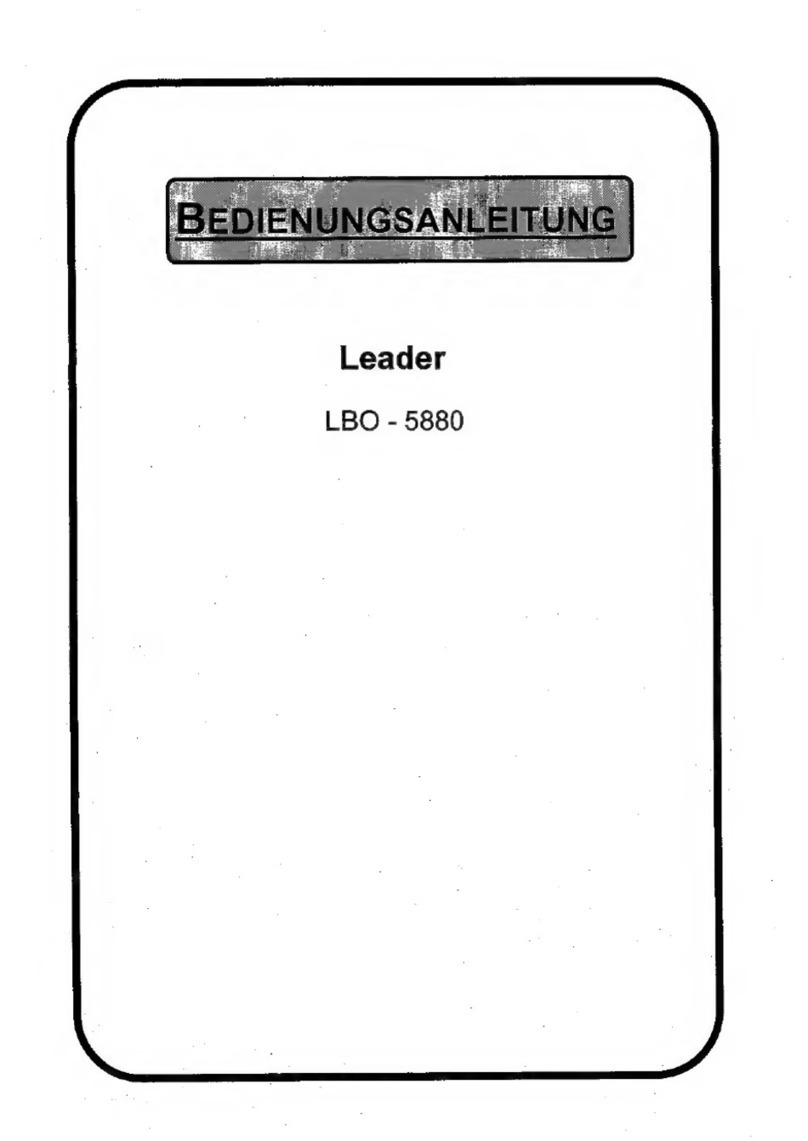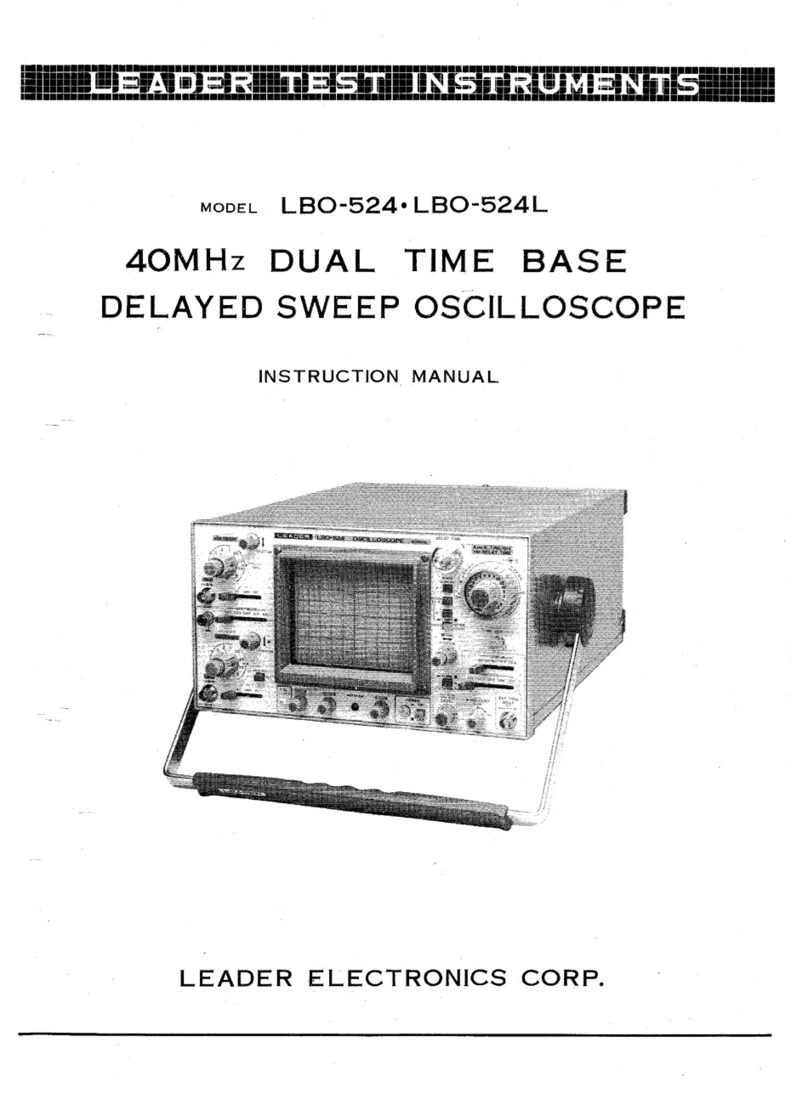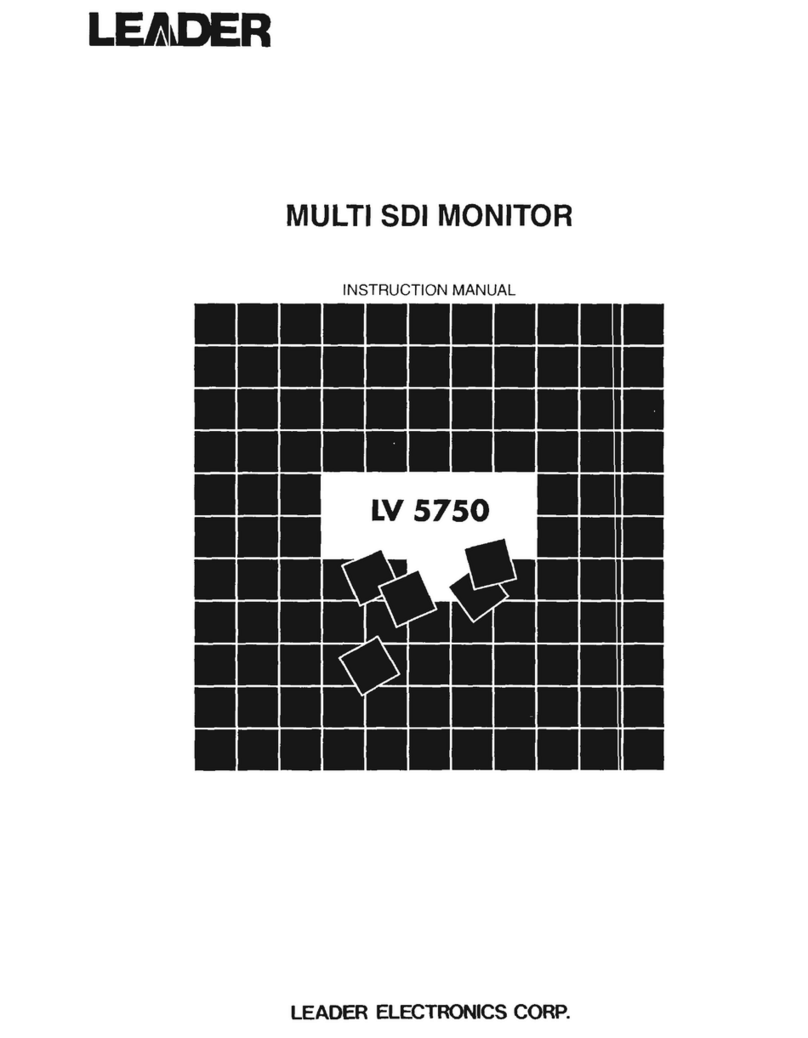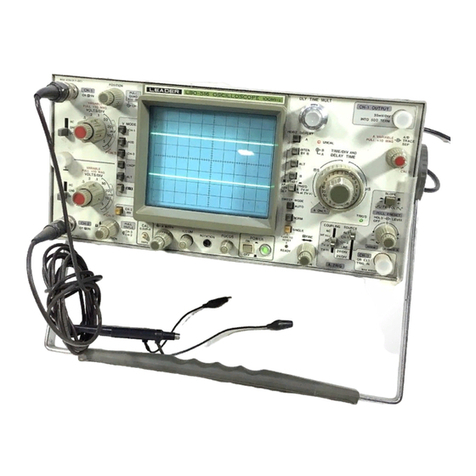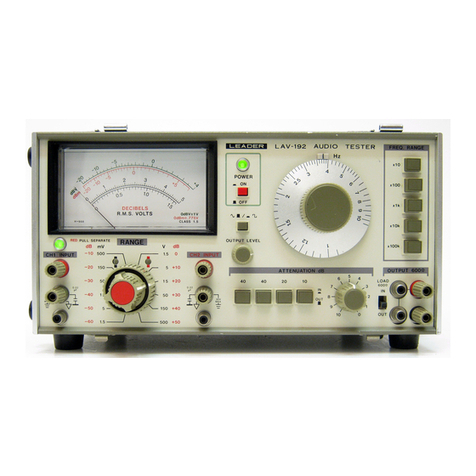Leader LT 450 User manual

LT 450
MULTIFORMAT PATTERN GENERATOR
INSTRUCTION MANUAL

TABLE OF CONTENTS
GENERAL SAFETY SUMMARY ......................................................................................... I
1. INTRODUCTION.......................................................................................................... 1
1.1 Scope of Warranty.................................................................................................................... 1
1.2 Operating Precautions.............................................................................................................. 1
1.2.1 Line Voltage and Fuse....................................................................................................... 1
1.2.2 Maximum Allowable Input Voltage..................................................................................... 2
1.2.3 Shorting the Output Connectors, Reverse Voltage............................................................ 2
1.2.4 Mechanical Shock ............................................................................................................. 2
1.2.5 Damage Caused by Static Electricity................................................................................. 2
1.2.6 About the Electric Shock Hazard etc. ................................................................................ 2
1.2.7 About Preheating............................................................................................................... 2
1.2.8 Trademark Acknowledgments ........................................................................................... 2
2. SPECIFICATIONS ....................................................................................................... 3
2.1 General..................................................................................................................................... 3
2.2 Features ................................................................................................................................... 3
2.3 Specifications............................................................................................................................ 5
2.3.1 Output Formats.................................................................................................................. 5
2.3.2 Output Signals................................................................................................................... 5
2.3.3 Output Patterns ................................................................................................................. 9
2.3.4 External Interface .............................................................................................................. 9
2.3.5 Preset/Recall ...................................................................................................................10
2.3.6 Startup Memory ............................................................................................................... 10
2.3.7 General Specifications..................................................................................................... 10
2.4 LT 45SER01 (DVI-I unit) .........................................................................................................11
2.4.1 General............................................................................................................................ 11
2.4.2 Features .......................................................................................................................... 11
2.4.3 Specifications ..................................................................................................................11
2.5 LT 45SER02 (HDMI unit) ........................................................................................................ 12
2.5.1 General............................................................................................................................ 12
2.5.2 Features .......................................................................................................................... 12
2.5.3 Specifications ..................................................................................................................12
2.6 LT 45SER03 (SCART unit) ..................................................................................................... 13
2.6.1 General............................................................................................................................ 13
2.6.2 Features .......................................................................................................................... 13
2.6.3 Specifications ..................................................................................................................13
3. PANEL DESCRIPTION .............................................................................................. 15
3.1 Front panel ............................................................................................................................. 15
3.2 Rear Panel.............................................................................................................................. 18
4. OPERATING PROCEDURE ...................................................................................... 21
5. OUTPUT FORMAT..................................................................................................... 22
5.1 Selecting the Output Format................................................................................................... 22

5.2 Setting the Sync Signal........................................................................................................... 23
5.3 Selecting the Signal Format (COMPONENT) ......................................................................... 23
5.4 Setting the Aspect Ratio (ASPECT)........................................................................................ 24
5.5 Setting the Audio Signal.......................................................................................................... 24
6. OUTPUT PATTERNS................................................................................................. 25
6.1 Selecting the Output Pattern................................................................................................... 25
6.2 Setting the Saturation ............................................................................................................. 25
6.3 Setting the Output Signal (G, B, R) ......................................................................................... 26
6.4 Setting Inversion..................................................................................................................... 26
6.5 Output Pattern Description ..................................................................................................... 27
6.5.1 Color Bar ......................................................................................................................... 27
6.5.2 Raster.............................................................................................................................. 28
6.5.3 Ramp............................................................................................................................... 29
6.5.4 Step ................................................................................................................................. 30
6.5.5 Convergence ................................................................................................................... 30
6.5.6 Crosshatch ......................................................................................................................31
6.5.7 Multiburst......................................................................................................................... 31
6.5.8 Character......................................................................................................................... 32
6.5.9 Window............................................................................................................................ 32
6.5.10 Monoscope...................................................................................................................... 33
6.5.11Natural Picture (option).................................................................................................... 33
6.5.12 Other Patterns ................................................................................................................. 34
7. I/O CONNECTORS.................................................................................................... 35
7.1 Component Output Connectors .............................................................................................. 35
7.2 D Connector ........................................................................................................................... 35
7.3 RGB Output Connector........................................................................................................... 37
7.4 DVI-I Output Connector ..........................................................................................................37
7.5 HDMI Output Connector and Audio Signal Input Connector ................................................... 39
7.6 Composite Output Connector ................................................................................................. 40
7.7 Y/C Separation Signal Output Connector ............................................................................... 41
7.8 SCART Connector (option)..................................................................................................... 42
7.9 Sync Signal Output Connector ............................................................................................... 44
7.10 Audio Signal Output Connector .............................................................................................. 44
8. CONFIGURATION ..................................................................................................... 45
8.1 Menu Screen .......................................................................................................................... 45
8.2 Setting the Cursor................................................................................................................... 46
8.2.1 Turning the Cursor On and Off ........................................................................................ 47
8.2.2 Cursor Position................................................................................................................ 47
8.2.3 Cursor Level ....................................................................................................................49
8.2.4 Cursor Line Width............................................................................................................ 50
8.3 Setting ID Characters ............................................................................................................. 51
8.3.1 Turning ID Characters On and Off................................................................................... 52
8.3.2 Displayed ID Character Contents .................................................................................... 52
8.3.3 ID Character Size and Number of Characters ................................................................. 54
8.3.4 ID Character Position ...................................................................................................... 55

8.3.5 Entering ID Characters .................................................................................................... 56
8.3.6 ID Character Level........................................................................................................... 57
8.3.7 Scrolling the ID Characters.............................................................................................. 58
8.3.8 ID Character Blinking....................................................................................................... 59
8.4 Configuring the Pattern Scroll Feature.................................................................................... 60
8.4.1 Turning the Pattern Scroll Feature On and Off ................................................................ 61
8.4.2 Pattern Scroll Direction.................................................................................................... 61
8.4.3 Pattern Scroll Speed........................................................................................................ 62
8.5 Setting the Level..................................................................................................................... 62
8.5.1 Setting Temporary Levels ................................................................................................ 63
8.5.2 Component Signal Levels................................................................................................ 64
8.5.3 Composite Signal Levels ................................................................................................. 65
8.6 Configuring the Recall Feature ............................................................................................... 66
8.6.1 Specifying the Recall Range............................................................................................ 66
8.6.2 Recalling Panel Settings.................................................................................................. 67
8.7 Configuring the Preset Feature............................................................................................... 68
8.7.1 Saving the Panel Settings ............................................................................................... 69
8.7.2 Power-on Panel Settings ................................................................................................. 70
8.8 Configuring the HDMI............................................................................................................. 71
8.8.1 Turning HDCP, CEC, and DDC On and Off ..................................................................... 72
8.8.2 Configuring the HDMI Output .......................................................................................... 73
8.8.3 HDMI Information Display................................................................................................ 74
8.9 Configuring the DVI-I .............................................................................................................. 76
8.9.1 Turning HDCP and DDC On and Off ............................................................................... 76
8.9.2 Configuring the DVI-I Output ........................................................................................... 77
8.9.3 Displaying DVI-I Information............................................................................................ 78
8.10 Configuring the DVI-I on an Option......................................................................................... 79
8.10.1 Turning HDCP and DDC On and Off ............................................................................... 79
8.10.2 Configuring the DVI-I Output on an Option...................................................................... 80
8.10.3 Displaying DVI-I Information on an Option ...................................................................... 81
8.11Configuring the HDMI on an Option........................................................................................ 82
8.11.1 Turning HDCP, CEC, and DDC On and Off ..................................................................... 82
8.11.2 Configuring the HDMI Output on an Option..................................................................... 83
8.11.3 Displaying an Option’s HDMI Information........................................................................ 84
8.12 Configuring the SCART Connection on an Option.................................................................. 85
8.12.1 SCART Output Mode on an Option ................................................................................. 85
8.12.2 SCART Sync Signal on an Option ................................................................................... 86
8.12.3 SCART Option RGB STATUS Control Signal .................................................................. 86
8.13 Configuring the Pattern Change ............................................................................................. 87
8.13.1 Turning Pattern Change On and Off................................................................................ 87
8.14 Configuring Closed Captioning ............................................................................................... 88
8.14.1 Turning Closed Captioning On and Off............................................................................ 88
8.15 Configuring the Audio Signal .................................................................................................. 92
8.15.1 Audio Signal Level........................................................................................................... 92
8.16 Setting the Clock Frequency................................................................................................... 93
8.16.1 Changing the Clock Frequency ....................................................................................... 93
8.16.2 Resetting the Clock Frequency ....................................................................................... 94

8.17 System Configuration ............................................................................................................. 95
8.17.1 Configuring the Ethernet Interface................................................................................... 95
8.17.2 Configuring the RS232C Interface................................................................................... 97
8.17.3 Setting the Date and Time ............................................................................................... 97
8.17.4 Configuring the LCD Panel.............................................................................................. 98
8.17.5 Initializing Settings...........................................................................................................99
8.17.6 USER SETTING Feature................................................................................................. 99
8.17.7 Displaying Version Information ...................................................................................... 100
8.17.8 Configuring License Settings......................................................................................... 101
9. EXTERNAL INTERFACE ......................................................................................... 102
9.1 Controlling the LT 450 through the Ethernet or RS232C Port ............................................... 102
9.1.1 Ethernet Port ................................................................................................................. 102
9.1.2 RS232C Port ................................................................................................................. 103
9.1.3 Controlling the LT 450.................................................................................................... 104
9.1.4 List of Commands.......................................................................................................... 106
9.2 Connecting to the LG 226 through the RS232C Port............................................................ 116
9.3 Controlling the Recall Address through the Remote Connector............................................ 119
9.4 Controlling the LT 450 through the Front Panel USB Port .................................................... 121
9.5 Saving Preset Memories through the Rear Panel USB Port................................................. 121
10. OPTIONS................................................................................................................. 122
10.1 Installing an Option............................................................................................................... 122
11. CALIBRATION AND REPAIRS................................................................................. 125
12. REFERENCE ........................................................................................................... 126
12.1 Output Signals ...................................................................................................................... 126
12.2 Menu Tree ............................................................................................................................ 130
12.3 List of Settings ...................................................................................................................... 136
12.4 Firmware Change History ..................................................................................................... 142

I
GENERAL SAFETY SUMMARY
■To Avoid Personal Injury
It is recommended that only qualified personnel with technical knowledge use this instrument only
after reading and fully understanding all functions of the instrument described this instruction
manual.
This instrument is not designed and manufactured for consumers.
If you do not have enough knowledge on electricity, to avoid personal injury and prevent damage to
this product, please be sure to use this product only under the supervision of an engineer who has
sufficient knowledge about electronics.
■Precautions on Contents
Should you find the contents in this manual and any of its technical terms confusing, please feel
free to contact your local LEADER agent.
■Symbols and Terms
Following terms and symbols indicate necessary warnings and cautions used in this manual and on
the product are there for safe operation.
<Symbol>
The sections where this symbol is marked in this manual or instrument, if not
correctly performed or practiced, could result in personal injury or cause
serious danger to the instrument. Misuse could also produce unintentional
movement to create an operational impediment on the instrument or other
products that might be connected to it.
Be sure to refer to the safety precautions in this manual to safely use the part
of the instrument where the symbol is marked.
<Term >
Warning statements identify warning conditions that if disregarded or not
correctly performed or adhered to, could result in serious personal injury or
even loss of life.
<Term >
Caution statements identify caution conditions that if disregarded or not
correctly performed or adhered to, could result in personal injury or damage to
the instrument.

II
GENERAL SAFETY SUMMARY
Review the following safety precautions to avoid operator's injury and loss of life and prevent damage
and deterioration to this instrument. To avoid potential hazards, use this product as specified.
■Warnings on the Cases and Panels of the Instrument
Operator should not remove any cases or panel for any reasons. If you touch inside the
instrument it could result personal shock or fire hazard. Refrain from spilling any liquid on or
inserting anything flammables or piece of metal into the ventilation of the instrument. Such
actions could cause fire, shock, malfunction and be an accident hazard while the power is on.
■Warnings on Power Line
Make sure to connect only to the rated power line voltage. Excess voltage may cause fire.
Confirm the voltage of the commercial power line before connecting the AC power cord.
The power frequency of the power line should be 50/60 Hz.
Warning on the Power Cord
Use only the optional power cord that is attached to this instrument. The use of the power cord
other than that attached could cause fire hazard. If the attached cord is damaged, stop using it
and contact your local LEADER agent. Should you use a damaged cord, it could cause a shock
or create a fire hazard. When you pull out the cord be sure to hold it by plug and pull from the
socket not by holding the cord wire.
■Warning on Fuse
When the fuse is melted the instrument stops operation. If the fuse melted, turn off the power
switch and disconnect the power plug from the socket. If you change the fuse while the cord is
connected to the socket, it could cause a shock hazard. Only use the specified type and rated
current and voltage fuses.
If the cause for melting fuse is unclear or if you suspect there is damage to the instrument or if
you have no proper fuse at hand please contact your local LEADER agent.

III
GENERAL SAFETY SUMMARY
■Warning on Installation Environment
●About the Operating Temperature Range
Operate the instrument between the temperature range of 0 to 40 °C. Operating the
instrument at higher temperatures could cause a fire hazard. Be sure not to obstruct air
circulation.
Rapid changes of temperatures from cold to warm can create internal moisture or
condensation and could damage the instrument. If there is a possibility of moisture
condensation, allows the instrument to sit for 30 minutes without the power on.
●About the Operating Humidity Range
Operating humidity range is ≤85 % RH. (without condensation)
Do not operate the instrument with wet hands. This could cause a shock and fire hazard.
●About the Operation in the Presence of Gasses
Operating the instrument in and near the presence or storage locations of flammable,
explosive gasses or fumes could create an explosion and fire hazard. Do not operate the
instrument anywhere near such environments.
●Avoid Insertions
Do not insert metals or flammable objects or drop liquid on or into the instrument. To do so
could cause fire, shock, malfunction and create a dangerous accident hazard.
■Warning While Operating
While operating the instrument if smoke, fire, or a bad smell occurs, turn off the instrument at
once for it could cause a fire hazard. When such a case occurs, turn off the power switch and
pull the plug of the cord from the plug socket. Contact your local LEADER agent after confirming
there is no fire.
■Warning About Ground
The instrument has a ground terminal to avoid electric shock hazard and to protect the
instrument from damage. Ensure that the product is properly grounded for safe operation.
■Warnings Concerning the LCD Panel
Glass is used on the LCD panel. If you break the glass, the fragments may cause injury. Do not
apply strong shock to the glass or damage the surface of the glass with sharp metal objects.

IV
GENERAL SAFETY SUMMARY
■Caution on Input/Output Terminals
Input terminals are rated with a maximum input. Do not supply an input over the specified rating
in the standard section of the instruction manual. Also, do not supply external power to Output
terminal, this could cause the instrument to malfunction.
■Caution When Not Using the Instrument For a Long Time
Make sure to disconnect the power cord from the socket when you do not use the instrument for
a long time.
■Caution on Connection of the Instrument and a Display
While the instrument is being connected with a ground terminal of the display, connect or
disconnect the signal cable.
By connecting the ground of the display with the instrument, the output part of the instrument
becomes difficult to break easily.
Be careful especially, when you connect the display under development.
Connect the ground by the following method.
・The ground terminal of the instrument connects with the ground of the display.
・Ground the instrument through the power cord, and ground the display.

V
GENERAL SAFETY SUMMARY
■Routine Maintenance
Remove the power cord plug from the socket when cleaning the instrument.
Avoid the use of thinner or benzene solvents for cleaning cases, panels and knobs since this might
remove the paint or damage plastic surfaces.
Wipe cases, panels, and knobs lightly with a soft cloth damped with neutral detergent.
Do not allow water, detergent, or other foreign objects to enter the instrument while cleaning.
If a liquid or metal object enters the instrument, it can cause electric shock or fire.
■EU WEEE Directive
The EU WEEE Directive applies to this product and its accessories. When disposing of this product
or its accessories, follow the regulations in your country or region.
(WEEE Directive: Waste Electrical and Electronic Equipment)
・・・・・・・・・・・・・・・・・・・・・・・・・・・・・・・・・・・・・・・・・・・・・・・・・・・・・・
Please conform to the above warnings and cautions for safe operation. There are cautions in each area
of this instruction manual, so please conform to each caution.
If you have any questions about this manual, please feel free to contact your local LEADER agent.

1. INTRODUCTION
1
1. INTRODUCTION
Thank you for purchasing LEADER’s measuring instruments.
Please read this instruction manual carefully to ensure correct and safe operation.
If you have any difficulties or questions on how to use the instrument after you have read this
manual, please feel free to contact your local LEADER agent.
After you have read the manual, keep the manual in a safe place for quick reference.
1.1 Scope of Warranty
This LEADER instrument has been manufactured under the strictest quality control guidelines.
LEADER shall not be obligated to furnish free service during the warranty period under the
following conditions.
1 Repair of malfunction or damages resulting from fire, natural calamity, or improper voltage
applied by the user.
2 Repair of an instrument that has been improperly repaired, adjusted, or modified by
personnel other than a factory-trained LEADER representative.
3 Repair of malfunctions or damages resulting from improper use.
4 Repair of malfunctions caused by devices other than this instrument.
5 Repair of malfunctions or damages without the presentation of a proof of purchase or
receipt bill for the instrument.
1.2 Operating Precautions
1.2.1 Line Voltage and Fuse
Confirm that the power line voltage is correct before connecting the power cord.
The voltage range and fuse rating are indicated on the rear panel.
The instrument must be connected to the rated line voltage and line frequency of 50 Hz to 60
Hz.
When replacing the fuse, turn the power switch off and disconnect the power cord from the
outlet.
When replacing the fuse, use the correct fuse that matches the line voltage.
Table 1-1 Voltage range and fuse rating
Voltage Range Fuse Rating LEADER Parts Number
90 to 250 V 1.0A, time-lag 436 3565 017

1. INTRODUCTION
2
1.2.2 Maximum Allowable Input Voltage
The maximum allowable input voltage to the input connectors is shown in the table 1-2 below.
Do not apply excessive voltage to prevent damage to the instrument.
Table 1-2 Maximum allowable input voltage
Input Connector Maximum Input Voltage
REMOTE (2 to 8p, 10 to 15p) -0.7V to 5.7V
AUDIO COAXIAL INPUT 3.6V
1.2.3 Shorting the Output Connectors, Reverse Voltage
Do not short any output connectors to prevent damage the instrument.
Do not supply external power to Output terminal, this could cause the instrument to
malfunction. Otherwise, you may damage the instrument or other property.
1.2.4 Mechanical Shock
Please be careful not to expose the instrument to other forms of severe mechanical shock as
this product contains shock sensitive precise parts.
1.2.5 Damage Caused by Static Electricity
Electronic parts are susceptible to damage from electrostatic discharge (ESD). The core
wire of the coaxial cable may be charged with static electricity. If you are connecting a
coaxial cable that is not connected on either end to an input/output connector of the
instrument, short the cable’s core wire and external conductor beforehand.
1.2.6 About the Electric Shock Hazard etc.
When you perform an examination and adjustment of a television, VTR, and other related
devices, refer to the service manual of each device.
When you connect this instrument to the inside of a device to be measured, be sure to
remove that power cord from a socket, and an electric shock hazard should not occur.
Especially when you connect this instrument to the device which contains high-voltage
circuits, such as television, wears the glove which endures the high voltage and be careful of
it not to get an electric shock.
1.2.7 About Preheating
To secure more accurate operation, turn on the power before about 30 minutes of use, and
stabilize an internal temperature.
1.2.8 Trademark Acknowledgments
HDMI, the HDMI logo, and High-Definition Multimedia Interface are trademarks or registered
trademarks of HDMI Licensing, LLC.

2. SPECIFICATIONS
3
2. SPECIFICATIONS
2.1 General
The LT 450 is a DTV-compatible multiformat pattern signal generator equipped with analog
component outputs, analog composite outputs, and digital outputs. It generates monoscope,
color bar, ramp, crosshatch, multiburst, character, and other test patterns.
You can add additional digital outputs such as DVI-I and HDMI and analog outputs such as a
SCART connector by ordering options.
2.2 Features
●Multiformat Support
With the formats available on the LT 450, you can test most video displays, including
television sets, PC monitors, and projectors.
The LT 450 supports 19 component output formats that comply with the DTV formats of
various countries including 1920×1080, 1280×720, 720×480, and 720×576. It supports 8
composite output formats: NTSC-M, NTSC-J, NTSC 4.43, PAL, PAL-M, PAL-N, PAL-60,
and SECAM.
In addition, for PC monitors, the LT 450 supports five VESA MTS formats (VGA, SVGA,
XGA, SXGA, and UXGA) and seven VESA CVT formats.
●RGB and YPBPRSignal Outputs
The analog and digital component video output signal formats can be switched between
RGB and YPBPR.
●S Output Connector
Equipped with an S connector for Y/C separation signal output. An ID signal is
superimposed on the C signal.
●Sync Signal Outputs
Equipped with sync signal connectors that transmit CS (tri-level or bi-level), HD, and VD
signals.
●Analog Audio Output
You can set the frequency (400 Hz or 1 kHz) and turn the output on and off on the left and
right channels separately.
●Simple Motion Picture
You can make any test pattern into a simple motion picture pattern by scrolling it vertically,
horizontally, or diagonally.
●Variable Output Level Feature
You can set the video signal level and sync signal level from 0 to 100 %.
●Closed Captioning and Teletext
Supports closed captioning. (V-Chip, VBI Teletext, CGMS, and WSS are not supported.)

2. SPECIFICATIONS
4
●Remote Control via RS232C
The LT 450 can be remotely controlled from a PC.
●Preset/Recall Features
Up to 100 panel settings of output formats and test patterns can be stored and recalled.
●D Output Connector
Equipped with a JEITA CP-4120 D5 output. ID signals (lines 1, 2, and 3) are supported.
●RGB Output Connector
Equipped with a mini D-sub 15-pin connector—an analog interface for PC monitors.
●DVI-I Output
Equipped with a DVI-I connector—a digital interface for PC monitors. Can be used to
check HDCP-compliant copyright protection functions and to make simple checks on the
DDC function.
You can use an adapter or a similar device to connect the output to an HDMI display.
However, audio output and CEC features are not supported.
●HDMI Output
Equipped with an HDMI connector—a digital interface used in household televisions and
set-top boxes. It can be used to check HDCP-compliant copyright protection functions and
to make simple checks on CEC and DDC functions.
●On-screen Display of HDCP and CEC Check Results
The pass/fail results of checking the HDCP copyright protection functions and CEC
functions on the DVI-I and HDMI outputs can be displayed on screen.
●Output Unit Options
You can add output units according to your objectives.
・LT 45SER01 (DVI-I unit)
・LT 45SER02 (HDMI unit)
・LT 45SER03 (SCART unit)
●TIMING AND PICTURE TOOL Option (LT 45SER04)
You can transmit timing and picture data that was made on an external PC to the LT 450.
You can then generate these timings and pictures from the LT 450.

2. SPECIFICATIONS
5
2.3 Specifications
2.3.1 Output Formats
Output Formats Component HDTV: 15 formats
Component SDTV: 4 formats
Component PC monitor: 12 formats
Composite: 8 formats
* For details on output formats, see Table 12-1, “List of output formats.”
2.3.2 Output Signals
Analog Component Signal
Standards
HDTV SMPTE 274M, SMPTE 295M, SMPTE 296M,
SMPTE RP 211
SDTV ITU-R BT.601, ITU-R BT.1358
PC monitor VESA MTS (Monitor Timing Specifications),
VESA CVT
Video Signal Format RGB or YPBPRselectable
Only RGB output is available for PC monitors
(excluding VGA). Only YPBPRoutput is available for
xvYCC.
Data Quantization Bits 10 bits
Output Impedance 75 Ω
Output Connector BNC
Number of Outputs 2
Sync Signal ON/OFF selectable for RGB
HDTV Tri-level sync added to G/Y, B/PB, and R/PR
SDTV Bi-level sync added only to G/Y
PC monitor Bi-level sync added only to G/Y (SYNC ON G)
Inversion Available
Variable Output Levels
Video Signal The video signal levels for RGB and YPBPRcan be
adjusted separately (linked to DVI-I and HDMI)
Sync Signal HSYNC and VSYNC levels can be adjusted
simultaneously.
Variable Range 0 to 100 % (in 1 % steps). The normal level is 100 %.
* Unless specified otherwise, these specifications apply to HDTV, SDTV, and PC monitors.

2. SPECIFICATIONS
6
Composite Signal and Y/C Separation Signal
Standards SMPTE 170M, ITU-R BT.470
Y/C Separation JEITA CPR-1201
Color Encoding NTSC-M, NTSC-J, NTSC 4.43, PAL, PAL-M, PAL-N,
PAL-60, SECAM
Data Quantization Bits 10 bits
Setup Level
NTSC-M, PAL-M 7.5 % (with variable setup level feature)
NTSC-J, NTSC 4.43 0 %
PAL, PAL-N, PAL-60, SECAM 0 %
Output Impedance 75 Ω
Output Connectors
Composite BNC
Y/C Separation S connector
Number of Outputs 1 each
Variable Output Levels Can be adjusted simultaneously with the Y/C
separation signal
Video Signal The video signal level can be adjusted after encoding.
Sync Signal HSYNC and VSYNC levels can be adjusted
simultaneously.
Burst Signal Amplitude can be adjusted.
Variable Range 0 to 100 % (in 1 % steps). The normal level is 100 %.
Aspect Ratio ID Signal Superimposed on the C signal of Y/C separation
signal only when NTSC-J is selected
DC Output Impedance 10 kΩ± 3 kΩ
Signal Level Fixed to 0 V for all formats except NTSC-J
S1 (squeeze) 5 V
S2 (Letterbox) 2.2 V
4:3 0 V
Inversion Available
Closed Captioning and Teletext Supports closed-captioning (V-Chip, VBI Teletext,
CGMS, and WSS are not supported.)
Sync Signal
CS Output
Output Impedance 75 Ω
Output Connector BNC
Number of Outputs 1
HD and VD Outputs
Level TTL Level
Output Connector BNC
Number of Outputs 1 each
Output Polarity Negative, except the output for PC monitors
(excluding VGA and XGA), which is positive
Can be changed through the USER SETTING feature

2. SPECIFICATIONS
7
Analog Audio Output
Frequency You can switch between OFF, 400 Hz, and 1 kHz for
the left and right channels separately.
Output Level -5.23 dBm or 0 dBm (at 600 Ωtermination)
Output Impedance 600 Ω
Output Connector RCA jack
Number of Outputs 2 (L/R)
D Connector (D5-Compatible)
Standards JEITA CP-4120(D1/D2/D3/D4/D5), RC-5237
Video Signal Component
Hot Plug Detection None (always output)
ID signals (Lines 1, 2, 3) Supported.
However, an LT 450 original output is used with
formats not listed in JEITA CP-4120.
DC Output Impedance 10 kΩ± 3 kΩ
Auxiliary Lines 1, 2, 3 Not used (not connected)
Connector D connector (JEITA RC-5237 compliant)
RGB Connector
Video Signal Component
Connector Mini D-sub 15-pin
DVI-I
Standards DVI 1.0, HDCP 1.2
Analog Signal Component
TMDS
Signal Format RGB/YPBPR4:4:4 8 bit and YPBPR4:2:2 8/10/12bit
Linked with the HDMI signal format.
Fixed to GBR/YPBPR4:4:4 8 bit when HDMI Deep
Color is selected.
Only RGB output is available for PC monitors
(excluding VGA).
Link Single
Variable Output Levels
Video Signal The video signal levels for RGB and YPBPRcan be
adjusted separately.
(Linked to analog component and HDMI)
Variable Range 0 to 100 % (in 1 % steps). The normal level is 100 %.
HDCP Includes a production key
Verification Result Display PASS/FAIL (displayed on screen)
DDC DDC2B
Hot Plug Detection ON/OFF selectable using the menu
Connector DVI-I
* You can use an adapter or a similar device to connect the DVI-I connector to an HDMI display. However,
audio output and CEC features are not supported.

2. SPECIFICATIONS
8
HDMI
Standards HDMI, HDCP 1.2
TMDS
Signal Format RGB/YPBPR4:4:4 8 bit, YPBPR4:2:2 8/10/12 bit
Only RGB output is available for PC monitors
(excluding VGA).
Deep Color RGB/YPBPR4:4:4 10/12 bit
Formats 1080p/59.94, 1080i/59.94, 1080i/50, 720p/59.94,
720p/50, 480p/59.94, 480i/59.94, 576p/50,
576i/50, VGA (640×480)
xvYCC
Supported Formats 1080p/59.94, 1080i/59.94, 1080i/50, 720p/59.94,
720p/50
Link Single
Variable Output Levels
Video Signal The video signal levels for RGB and YPBPRcan be
varied separately.
(Linked to analog component and DVI-I)
Variable Range 0 to 100 % (in 1 % steps). The normal level is 100 %.
Audio
Internal
Format IEC 60958-3
CH 2
Output Level 0 dBm, -5.23 dBm
Frequency You can switch between OFF, 400 Hz, and 1 kHz for
the left and right channels separately.
Sampling Frequency 32 kHz, 44.1 kHz, 48 kHz
Quantization Bits 16 bits
External Input SPDIF coaxial
InfoFrame Supports AVI, SPD, AUDIO InfoFrame.
HDCP Includes a production key.
Verification Result Display PASS/FAIL (displayed on screen)
CEC Checks connection using the “<Polling Message>”
header block
Connection Check Result Display PASS/FAIL (displayed on screen)
Displays PASS if there is an ACK response to
“<Polling Message>”
DDC DDC2B
Hot Plug Detection ON/OFF selectable using the menu.
Connector HDMI Type A

2. SPECIFICATIONS
9
2.3.3 Output Patterns
Output Patterns Color bar, raster, ramp, step, convergence,
crosshatch, multi-burst, character, window,
monoscope, natural picture (option), and other
patterns
* For details on output patterns, see Table 12-2, “List of output patterns.”
Simple Motion Picture
Simple Motion Picture Pattern scroll
Scroll Directions Up/down and left/right
Scroll Speed Settings
Progressive
Vertical 0 to 256 lines/frame (1-line steps)
Horizontal 0 to 256 dots/frame (4-dot steps)
Interlace
Vertical 0 to 256 lines/field (2-line steps)
Horizontal 0 to 256 dots/field (4-dot steps)
Pattern Change
Function Automatically switches pattern displays according to
the specified format.
Switch interval Approx. 2 s
2.3.4 External Interface
RS232C port
Function Remotely control the LT 450 settings from an external
PC via RS232C.
Connector D-sub 9-pin (male)
USB Port (Front Panel)
Function Transmit timing and picture data that was made on an
external PC to the LT 450 through USB (option).
Connector USB (B type)
USB Port (Rear Panel)
Function Save and load preset data from USB memory.
Connector USB (A type)
Ethernet
Function Remotely control the LT 450 settings through Telnet
Remote
Function Increment or decrement the recalled address through
an external contact input.
Connector XM4K-1542-112 (by Omron)

2. SPECIFICATIONS
10
Option Slots (slots 1 to 3)
Function Holds option output units
(Output unit types can be selected freely.)
2.3.5 Preset/Recall
Function Stores and recalls up to 100 panel settings
(addresses 00 to 99).
Area Settings You can set the range of consecutive addresses to be
recalled from the 100 addresses.
BEGIN Recall start address
END Recall end address
2.3.6 Startup Memory
Function Stores the panel settings at power-on to the internal
memory
2.3.7 General Specifications
Environmental Conditions
Operating Temperature 0 to 40 ºC
Operating Humidity ≤85 % RH (without condensation)
Spec-Guaranteed Temperature 10 to 35 ºC
Spec-Guaranteed Humidity ≤85 % RH (without condensation)
Operating Environment Indoors
Operating Altitude ≤2,000 m
Overvoltage Category II
Pollution Degree 2
Power Requirements
Voltage 90 to 250 VAC
Frequency 50/60 Hz
Power Consumption 80 W max.
Dimensions 426 (W) × 88 (H) × 400 (D) mm (excluding
projections)
Weight 5.7 kg
Accessories Power cord ............................................. 1
Instruction Manual .................................. 1
Table of contents
Other Leader Test Equipment manuals
Popular Test Equipment manuals by other brands

Redtech
Redtech TRAILERteck T05 user manual

Venmar
Venmar AVS Constructo 1.0 HRV user guide

Test Instrument Solutions
Test Instrument Solutions SafetyPAT operating manual

Hanna Instruments
Hanna Instruments HI 38078 instruction manual

Kistler
Kistler 5495C Series instruction manual

Waygate Technologies
Waygate Technologies DM5E Basic quick start guide

StoneL
StoneL DeviceNet CK464002A manual

Seica
Seica RAPID 220 Site preparation guide

Kingfisher
Kingfisher KI7400 Series Training manual

Kurth Electronic
Kurth Electronic CCTS-03 operating manual

SMART
SMART KANAAD SBT XTREME 3G Series user manual

Agilent Technologies
Agilent Technologies BERT Serial Getting started
